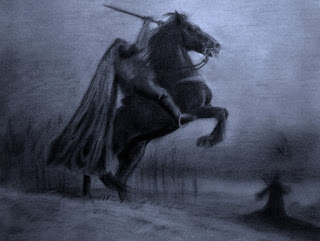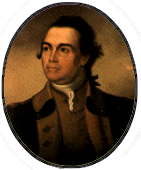An Excellent Plan:
 |
| General Howe |
In the summer of 1776, the British, and their Hessian (German) allies, defeated Washington’s forces in Brooklyn and Manhattan. But Washington’s ability to direct timely retreats, and General Howe’s reluctance to aggressively pursue the rebels, avoided total destruction. In September, the Continental Army was clinging to defensive positions at Harlem Heights on the northern tip of Manhattan, with the British army to their front and the Royal Navy (under the command of Howe's brother Richard) controlling the North (Hudson) and East Rivers. But the Continental Army's Harlem defenses were good, so in mid-October Howe tried a flanking maneuver by water, taking advantage of the Royal Navy's dominance. His objective was to cut across Westchester County and trap the Americans.
A Clever Strategy:
Leaving behind a holding force in Manhattan, Howe transported about 4,000 troops, mostly Hessians, up the East River toward Long Island Sound, for a landing at Throg’s Neck, today part of the Bronx. Howe’s goal was to cut off the American supply line to Connecticut, and the British commander also hoped to draw Washington out in a general engagement or to smash the Americans from the right flank while the holding force launched a frontal assault. Intelligence reports warned General Washington the enemy was enveloping him with a naval landing at his rear. In desperation, the beleaguered American commander in chief positioned the few forces at hand along key points. The numerous stone fences and marshy soil made the British approach difficult and his position defensible. But he realized that a determined effort by the British would likely prevail. Also, they could be planning other landings as well.
Prelude at the Neck:
 |
| General Clinton |
Taking of Pelham:
The British came ashore at dawn. General Clinton commanded the landing. His advance guard of 4,000 British light infantry and Hessian Jägers went in first. Waiting for them near Eastchester was the 750 strong brigade of Massachusetts Colonel John Glover. (Note: Glover is a minor but key character in the first two books of the Yankee Doodle Spies series.) Glover himself spied the British landing from the top of a hill overlooking the coast. He requested orders from his immediate commander, General Charles Lee. Lee was Washington's second in command (and also a key figure in the second book of the Yankee Doodle Spies, The Cavalier Spy). But Lee, although a former professional British officer, gave no orders. Glover realized the narrow causeways and inlets favored a defense. So the hard as flint Yankee that was Glover decided on his own to attack. He ordered his brigade into action. It was made up of the 14th, 13th, 3rd, and the 26th Massachusetts Continental Regiments. Glover held 150 Continentals behind in reserve. Glover's force soon made contact with enemy skirmishers. Glover put his own Marblehead Regiment (former seamen) in the front. At Breed's Hill Glover had witnessed the carnage inflicted when the British advanced in ranks against well-positioned infantry. He sent a company forward as an advance guard to hold the British in check. This bought him time to prepare a defense before the expected onslaught. Glover set up a series of ambushes by placing these forces in staggered positions. They cannily took advantage of the stone walls that lined either side of the lane that ran from the beach to the interior. His orders were to hold position as long as they could and then to fall back to a position in the rear. The next unit would then do the same. Glover planned a classic fighting withdrawal aimed at delaying an enemy's advance. Glover positioned himself with his advance guard. The Marbleheaders opened the battle by firing on advancing British. The pop of muskets and puffs of smoke to the front gave the British pause. Once more, the heavy lead balls began to zing by the advance guard, which deployed into action and returned fire. Volleys were exchanged and for a while, the Americans held the enemy advance. When the British brought up reinforcements, Glover's men pulled back in good order. Seeing the Americans retreating, the British fixed bayonets and came on. But 200 troops of the 13th Massachusetts Continentals anxiously waiting behind the next stone wall. On command, the Americans stood up and fired a devastating volley into the British at 30 yards - point-blank range. Surprised, the British column took heavy losses and fell back to the main body of the invading army.
 |
| Glover's Marblehead Regiment in action at Pelham |
Not to be denied, the British reorganized and once more attacked with all 4,000 men and seven cannon. They bombarded the Continentals stationed behind the stone wall. Under the cover of the artillery fire, the infantry launched its attack. But most British artillery rounds fell low or flew high. The few that crashed into the stone walls barely did damage. The bombardment had little effect. Prepared, the Americans unleashed another lethal volley on the advancing infantry at 50 yards. This time the British returned with volley after volley. The firefight went on for a long 20 minutes. Finally, the British artillery moved up in close support, and this time the effect was telling. Now under pressure from combined arms, the lead American regiment fell back. The next regiment provided strong covering fire to keep the British at bay until their comrades were safe. The British now turned and attacked the position of the 3rd Continentals, who were stationed behind a stone wall on the other side of the road. Both sides kept up a steady fire. The British moved forward several times and several times the American fire broke their lines. However, the British superior numbers eventually began to overwhelm the Americans. Realizing this, Glover pulled the regiment back to another stone wall on the crest of a hill. The next regiment in line, the 26th Continentals, soon engaged the advancing enemy. Once more using the cover of a stone wall, the 26th fired one last volley before Glover gave the order to retreat. Moving in good order, Glover's brigade crossed a bridge over the Hutchinson River. Glover left a rearguard of 150 men of the 14th Massachusetts Continentals to cover them. True to form though, Howe decided not to exploit the situation. He camped his forces on a hill on the opposite side of the stream but made no attempt to cross the stream. This enabled Glover to pull his brigade back to Yonkers.
 |
| Glover's smartly executed defensive withdrawal was as classic as the British amphibious tactics |
What was the (Pell's) Point?
With the British advance delayed, Washington left a small garrison at the fort on the heights that bears his name and safely evacuated the main American army north through Kingsbridge to Westchester. Howe's army slowly made its way through New Rochelle and Scarsdale. This was the prelude to the Battle of White Plains. The series of skirmishes resulted in relatively few casualties for both sides. But the canny American actions at Throg's Neck and Pelham bought Washington time to save his army from almost certain entrapment. A war of posts would soon turn into a war of movement.








































